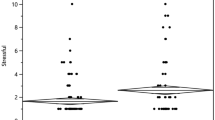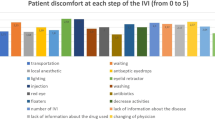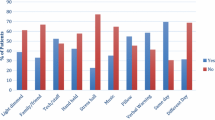Abstract
Purpose
This study compared pain and anxiety levels in individuals receiving intravitreal injections (IVIs) using a speculum-free injection technique, the lid splinting eyelid retraction technique, or using a speculum.
Methods
This was a prospective study of individuals receiving IVI at a single tertiary care medical center who responded to a questionnaire and visual analog scale (VAS) between December 2019 and January 2020. In one group, a speculum was used prior to injection, whereas in the other group, a speculum-free injection technique was used.
Results
A total of 108 individuals were included in this study: 54 received IVI with the speculum-free lid splinting eyelid retraction technique and 54 received IVI with a speculum. A correlation between pain and anxiety was demonstrated in the control group (p-value < 0.01); however, in the speculum-free group, this correlation was lower and not significant. When comparing pain and anxiety between the study groups, lower median pain (Mood’s: Z = 5.378, p-value < 0.001) and lower anxiety (Mood’s: Z = 2.108, p-value = 0.035) scores were demonstrated in the speculum-free group than in the control group. The distribution of pain scores was significantly different between the study groups (Kolmogorov–Smirnov: D = 0.518, p-value < 0.001), and trending differences in anxiety between the groups were observed (Kolmogorov–Smirnov: D = 0.259, p-value = 0.053).
Conclusion
The lid splinting eyelid retraction technique, a speculum-free technique, was associated with less anxiety and pain in patients than the use of a speculum. As IVI often involves repeated treatment, identifying modifiable factors that may relieve anxiety and pain is of utmost importance.



Similar content being viewed by others
Data availability
Data are available from the corresponding author upon request.
Code availability
Not relevant.
References
Grzybowski A, Told R, Sacu S et al (2018) 2018 update on intravitreal injections: euretina expert consensus recommendations. Ophthalmologica 239(4):181–193. https://doi.org/10.1159/000486145
Wykoff CC, Flynn HW Jr (2011) Endophthalmitis after intravitreal injection: prevention and management. Retina 31(4):633–635. https://doi.org/10.1097/IAE.0b013e31821504f2
Munro M, Williams GR, Ells A et al (2018) Lid splinting eyelid retraction technique: a minimised sterile approach for intravitreal injections. Br J Ophthalmol 102(9):1254–1258. https://doi.org/10.1136/bjophthalmol-2017-311081
Fineman MS, Hsu J, Spirn MJ et al (2013) Bimanual assisted eyelid retraction technique for intravitreal injections. Retina 33(9):1968–1970. https://doi.org/10.1097/IAE.0b013e318287da92
Tailor R, Beasley R, Yang Y et al (2011) Evaluation of patients’ experiences at different stages of the intravitreal injection procedure - what can be improved? Clin Ophthalmol 5:1499–1502. https://doi.org/10.2147/OPTH.S24358
Chaturvedi R, Wannamaker KW, Riviere PJ et al (2019) Real-world trends in intravitreal injection practices among American retina specialists. Ophthalmol Retina 3(8):656–662. https://doi.org/10.1016/j.oret.2019.03.023
Green-Simms AE, Ekdawi NS, Bakri SJ (2011) Survey of intravitreal injection techniques among retinal specialists in the United States. Am J Ophthalmol 151(2):329–332. https://doi.org/10.1016/j.ajo.2010.08.039
Facco E, Zanette G, Favero L et al (2011) Toward the validation of visual analogue scale for anxiety. Anesth Prog 58(1):8–13. https://doi.org/10.2344/0003-3006-58.1.8
Santos KOCA, Dias EMF, Santos MdS et al (2021) Pain management during intravitreal injection: integrative review. BrJP 3:1–5
Moisseiev E, Regenbogen M, Bartfeld Y et al (2012) Evaluation of pain in intravitreal bevacizumab injections. Curr Eye Res 37(9):813–817
Karimi S, Mosavi SA, Jadidi K et al (2019) Which quadrant is less painful for intravitreal injection? A prospective study. Eye 33(2):304–312
Theunissen M, Peters ML, Bruce J et al (2012) Preoperative anxiety and catastrophizing: a systematic review and meta-analysis of the association with chronic postsurgical pain. Clin J Pain 28(9):819–841. https://doi.org/10.1097/AJP.0b013e31824549d6
Miller B, Shapira Y, Flores V et al (2019) Reducing perceived pain intensity during intravitreal injections by patient handholding. Ophthalmol Retina 3(5):451–453. https://doi.org/10.1016/j.oret.2018.12.004
Socea SD, Abualhasan H, Magen O et al (2020) Preoperative anxiety levels and pain during cataract surgery. Curr Eye Res 45(4):471–476
Wilde C, Awad M, Ross A et al (2018) Optimisation of intravitreal injection technique using a Barraquer speculum with solid flat blade and finger stabilisation. Eye 32(8):1413–1414
Miller B, Shapira Y, Flores V et al (2019) Reducing perceived pain intensity during intravitreal injections by patient handholding. Ophthalmology Retina 3(5):451–453
Segal O, Segal-Trivitz Y, Nemet AY et al (2016) Anxiety levels and perceived pain intensity during intravitreal injections. Acta Ophthalmol 94(2):203–204. https://doi.org/10.1111/aos.12802
Acknowledgements
The authors acknowledge the work of Sondra Turjeman, PhD, for her expert statistical analysis.
Author information
Authors and Affiliations
Corresponding author
Ethics declarations
Conflict of interest
The authors declare no competing interests.
Additional information
Publisher’s note
Springer Nature remains neutral with regard to jurisdictional claims in published maps and institutional affiliations.
Supplementary Information
Below is the link to the electronic supplementary material.
Supplementary file1 (MP4 116413 KB)
Rights and permissions
About this article
Cite this article
Wasser, L.M., Roditi, E., Weiss, A.R. et al. Anxiety and pain perception using a speculum-free eyelid retraction technique for intravitreal injection. Graefes Arch Clin Exp Ophthalmol 260, 2023–2028 (2022). https://doi.org/10.1007/s00417-021-05422-7
Received:
Revised:
Accepted:
Published:
Issue Date:
DOI: https://doi.org/10.1007/s00417-021-05422-7




